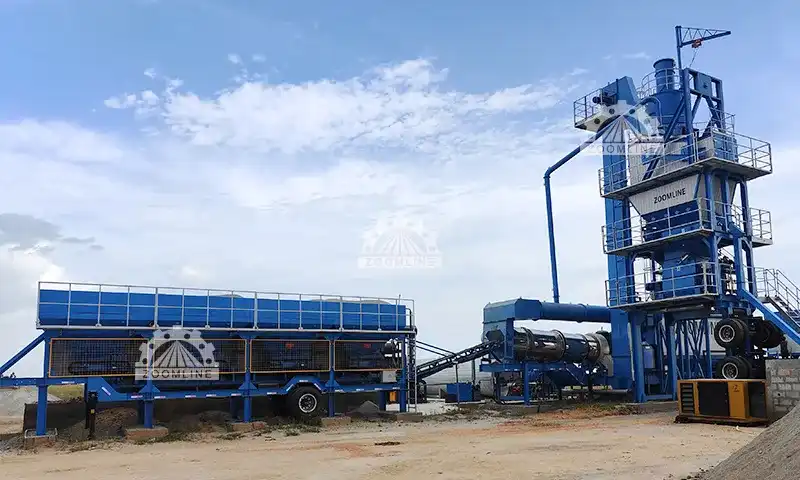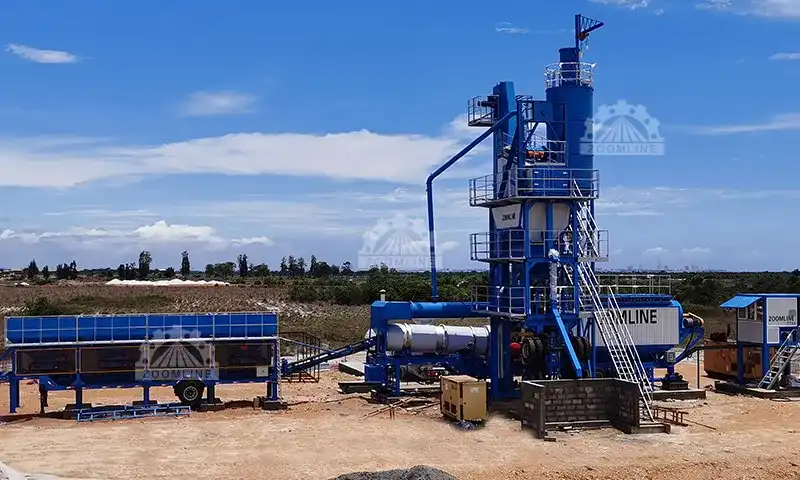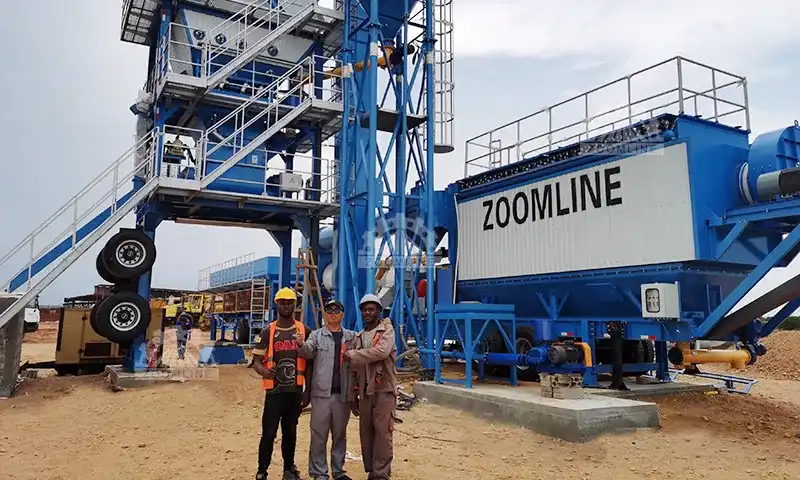As the core industrial facility for producing high-quality asphalt mixtures, the operational standardization of asphalt mixing plants directly determines production efficiency, product quality, and operational safety. Whether in raw material processing, equipment operation, or construction during special seasons, meticulous control over every detail is crucial. This article comprehensively breaks down key operational considerations for asphalt mixing plants, covering pre-operation preparation, real-time monitoring during operation, post-shutdown maintenance, and special requirements for winter construction. By examining the core asphalt production process, it aims to help operators mitigate risks and enhance productivity.
Pre-startup inspections and preparations at asphalt mixing plants serve as the first line of defense against production interruptions and equipment damage. Verify all aspects across three dimensions—equipment status, material conditions, and safety environment—to ensure no hidden hazards are overlooked.
Mechanical Component Inspection: Clear residual materials from aggregate batchers, hot aggregate hoppers, mixers, and all storage bins; ensure all discharge gates are closed. Inspect transmission components (e.g., sprockets, chains) for looseness and verify all connecting bolts are tightened to prevent component detachment during operation.
Lubrication and Fluid Inspection: Verify adequate lubricant/grease at all lubrication points (bearings, gears, etc.), ensure gearbox oil levels meet standards, and confirm pneumatic system oil levels are normal. Insufficient lubrication can cause operational stuttering or severe failures like bearing burnout.
Electrical System Inspection: Verify supply voltage aligns with equipment rating (±5% tolerance). Inspect switches, relays, motors, and cables for damage or leakage. Confirm instrument panel displays are normal and metering devices (e.g., aggregate/asphalt scales) meet accuracy standards. Calibrate promptly if deviations exist.
Auxiliary System Inspection: Start the air compressor to ensure air pressure meets operational requirements. Check the dust removal system water pump status to guarantee stable, uninterrupted spray volume. Confirm the asphalt supply system is functioning normally. Once asphalt temperature meets production standards, activate the asphalt pump to initiate self-circulation.
Material Verification: Confirm quantities, quality, and specifications of aggregates (crushed stone, sand), mineral powder, asphalt, fuel, etc., meet production formula requirements. Specifically monitor aggregate moisture content using moisture analyzers—moisture content not only impacts product quality but is also a key factor determining fuel consumption (Practice shows: For every 1% reduction in aggregate moisture content, fuel consumption decreases by 1kg per ton of finished product).
Site Clearance: Clear debris from the work area. Inspect protective equipment (e.g., guardrails, protective covers) for integrity and verify firefighting equipment (dry powder extinguishers, foam extinguishers, etc.) are complete and functional. Strictly prohibit storing tools or debris near operating equipment to prevent accidents caused by accidental collisions.

During asphalt mixing plant operation, real-time attention must be paid to equipment status, process parameters, and personnel safety. This ensures stable production capacity while eliminating risks from non-compliant operations.
Startup must follow the sequence “Auxiliary Systems → Core Equipment.” Reversing this sequence is strictly prohibited:
Close all branch circuit breakers and air switches;
Sequentially activate the induced draft fan, forced draft fan, mixer, vibrating screen, elevator, drying drum, and belt conveyor;
Observe each motor for 3 minutes after startup. Confirm no abnormal noise or vibration before proceeding with ignition.
Ignition Precautions: Insert the oil gun, activate the diesel pump ignition, and simultaneously start the pulverized and speed-regulating motor. Monitor flame status by adjusting the dampers of the induced draft fan and forced draft fan. If ignition fails, immediately close the burner throttle, ensure thorough ventilation, and retry. Before ignition adjustments, disconnect the high-voltage power supply to prevent electric shock.
Temperature Control: Drying drums must prevent aggregate overheating (to avoid material degradation) or excessive moisture (which affects mixture strength). During normal production, aggregate temperature must remain stable within the required process range. For winter operations, asphalt mixture discharge temperature must not fall below 150°C, with ambient air temperature exceeding 5°C. Equipment insulation via heaters is required when necessary.
Metering Accuracy: During initial production, operate in manual control mode for 8-10 batches. Switch to automatic control only after confirming no deviations in metering devices (aggregate, mineral powder, asphalt). Each batch must undergo sampling inspection to ensure gradation and binder-to-aggregate ratio meet project specifications.
Dust Collection System Management: When commissioning new bag-house dust collectors, continuously monitor flue gas temperature—excessive heat will burn filter bags, while insufficient heat may cause condensation and reduce filtration efficiency. Frequently observe differential pressure gauge readings; promptly address excessive or insufficient differential pressure to ensure the collector operates under negative pressure.
Unauthorized Absence Strictly Forbidden: Operators must continuously monitor all component statuses. Immediately shut down equipment upon detecting anomalies (e.g., abnormal motor noise, bearing overheating) and never operate with faults.
Prohibited Use of Emergency Stop Button: The emergency stop button is exclusively for sudden accidents (e.g., drum fires, personnel entering hazardous zones). It must never be used as a normal shutdown button. If activated, restarting requires strict adherence to the startup sequence.
Avoid Overloading: Never overload equipment to pursue higher output—excessive loading accelerates bearing wear and may trigger motor overload trips, ultimately reducing overall efficiency. If bearing strain noises are detected, immediately reduce feed rate.
Hazard zone control: When the hopper is raised, no personnel are permitted to work or pass beneath it. Before starting equipment, verify surrounding personnel locations and sound warning horns if necessary.
Improper shutdown procedures may cause residual materials to solidify and components to corrode, shortening equipment lifespan. Follow the standardized process: “Process Cleaning → Equipment Shutdown → Maintenance Inspection.”
Stop feeding when the hot aggregate storage bin holds enough material for the final 5-6 batches of mix production. After production completes, continue operation for 2-3 minutes before extinguishing the flame, simultaneously stopping the pulverizer and variable-speed motor.
Add fine stone and sand to the mixing drum, agitate for 5-10 minutes to remove residual asphalt mixture. Drain residual material from the hot aggregate storage bin to prevent clumping.
Shut down motors in reverse order: “Core Equipment → Auxiliary Systems.” First stop belt conveyors and drying drums, then hoists and mixers, finally exhaust fans and blowers.
The drying drum must continue operating until its temperature drops below 90°C before shutdown to prevent residual aggregate from solidifying at high temperatures on the drum walls, which could cause jamming during the next startup.

If the drying drum catches fire, immediately execute the “Three Stops, One Delivery, One Extinguishing” procedure:
Stop the burner, blower, and induced draft fan:
First press the “Stop” button on the burner control panel. After the flame extinguishes, sequentially shut down the blower and induced draft fan. Closely monitor equipment operating parameters throughout to ensure all components cease operation completely. Turn off the power switches for all equipment. Hang a “Equipment Under Maintenance, Do Not Operate” warning sign at the distribution panel to prevent accidental operation.
Cut off asphalt supply:
Immediately shut down the asphalt transfer pump to halt asphalt delivery to the mixing plant. After confirming pump stoppage, close the manual gate valve on the asphalt pipeline to prevent backflow. Drain residual asphalt from the pipeline to avoid solidification and blockage. Use compressed air to purge the pipeline, ensuring no residue remains.
Add high-moisture-content fine aggregate to the drum to suppress flames:
Select fine aggregate with a moisture content between 15% and 20%. Feed it into the drum at a constant rate via the feeding system. The addition volume should cover the surface of the material in the drum, typically calculated at 0.2-0.3 cubic meters of fine aggregate per cubic meter of material.
Maintain low-speed rotation during feeding to distribute fine aggregate evenly, absorb heat thoroughly, and reduce internal drum temperature.
Use dry powder or foam extinguishers at the external discharge port to extinguish fires. Directly spraying water onto the high-temperature drum is strictly prohibited:
Select ABC dry powder extinguishers or alcohol-resistant foam extinguishers. Maintain a safe distance of 3-5 meters and aim the spray at the base of the flames.
Assign personnel to monitor drum temperature changes during extinguishment. Proceed with maintenance only after temperature drops below 80°C. Never spray water directly onto the drum while hot to prevent sudden cooling of high-temperature components, which may cause equipment damage or explosions.
Clear residual material from the belt conveyor, flush accumulated dust from inside and outside the dust collection system, and unclog asphalt pipelines (to prevent asphalt solidification and blockage).
Conduct routine equipment inspections: replenish grease at all lubrication points, tighten loose bolts, and check electrical components for moisture.
Organize the work site, return tools to their designated locations, and ensure a clean environment before the next startup.
Low winter temperatures affect the flowability and setting speed of asphalt mixtures, requiring enhanced control across three aspects: materials, timing, and process.
Use modified asphalt or mixtures with low-temperature additives to enhance crack resistance at low temperatures;
Store aggregates and asphalt in dry, ventilated, insulated warehouses to prevent moisture absorption and freezing; apply anti-adhesive agents to transport vehicle compartments to prevent mixture sticking to the bottom.
Schedule construction during daily high-temperature periods (e.g., 10:00-16:00) and avoid post-sunset operations;
Optimize transport routes to reduce transit time from mixing plants to job sites, minimizing heat loss in cold conditions.
Employ high-frequency vibratory compactors. Use light-tonnage rollers for initial compaction; avoid rubber-tired rollers (rubber tires tend to stick to material at low temperatures).
Strictly prohibit traffic before pavement temperature drops below 50°C to prevent deformation caused by incomplete mixture setting.
Increase Marshall test frequency to ensure mix formation quality; conduct on-site core sampling with focus on density, void ratio, and other indicators;
Enhance machinery inspections to prevent hydraulic system failures caused by low temperatures; install prominent safety warning signs to alert workers to slippery conditions (ice on pavement or equipment surfaces).

More isn’t always better—it’s about supplying lubrication as needed. Critical components like sprockets and bearings running low on oil increase operational resistance. Prioritize automatic lubrication systems that lubricate during operation, minimizing downtime for maintenance.
Choosing the wrong plant type (e.g., batch plant vs. continuous mixer) without considering production needs leads to poor product quality and accelerated wear. Select equipment based on capacity and mix type (e.g., standard asphalt vs. modified asphalt).
Hiding unauthorized modifications or fault causes (e.g., self-replaced components) during professional repairs prolongs downtime, increases costs, and may create safety hazards. Disclose all equipment history to facilitate rapid fault diagnosis.
Critical components like burners, storage silos, belt conveyors, and thermal oil pumps require monthly checks. Early detection of minor issues (e.g., seal aging, loose bolts) prevents costly repairs or shutdowns later.
Operating an asphalt mixing plant is a process where “details determine success or failure” – from meticulous pre-startup checks to real-time monitoring during operation, and post-shutdown maintenance and cleaning, every step must strictly adhere to established protocols. Moreover, operators must possess professional skills (holding valid certifications after training) and adjust processes for specific seasons (like winter) to achieve “high-efficiency production + premium products” while ensuring safety.
For further insights into asphalt mixing plant installation, maintenance, or customized solutions, consult technical blogs from specialized equipment manufacturers for practical guidance. Regular equipment maintenance and operator training are essential safeguards for extending plant lifespan and reducing operational costs.